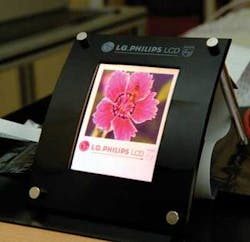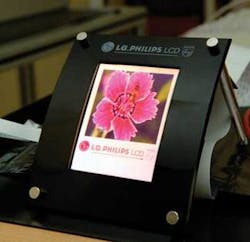LG.Philips LCD and UDC develop first a-Si flexible AMOLED display
Engineers at LG.Philips LCD (Seoul, Korea), a developer of thin-film-transistor liquid-crystal-display (TFT-LCD) technology, have created the first full-color flexible active-matrix organic-light-emitting-diode (AMOLED) display that uses amorphous-silicon (a-Si) technology. LG.Philips LCD developed the display in cooperation with Universal Display (UDC; Ewing, NJ), which holds the original patents for phosphorescent OLED (PHOLED) technology. By using a process known as electrophosphorescence developed by UDC and its partners at Princeton University and the University of Southern California, the company boosted the efficiency of a phosphorescent OLED four times higher than that of a conventional fluorescent OLED
The 4 in. full-color flexible AMOLED display has a 320 × 240 QVGA resolution and can reproduce 16.77 million colors. The display has a thickness of only 150 µm and uses a stainless metal-foil substrate to ensure durability and protection against heat, and also improves the manufacturing process and enhances product stability. Most important, using a-Si backplane technology allows LG.Philips LCD to use its existing TFT-LCD production line for these AMOLEDs, a major step toward demonstrating the commercial viability of such products. Contact DongHoon Hyun at [email protected].

